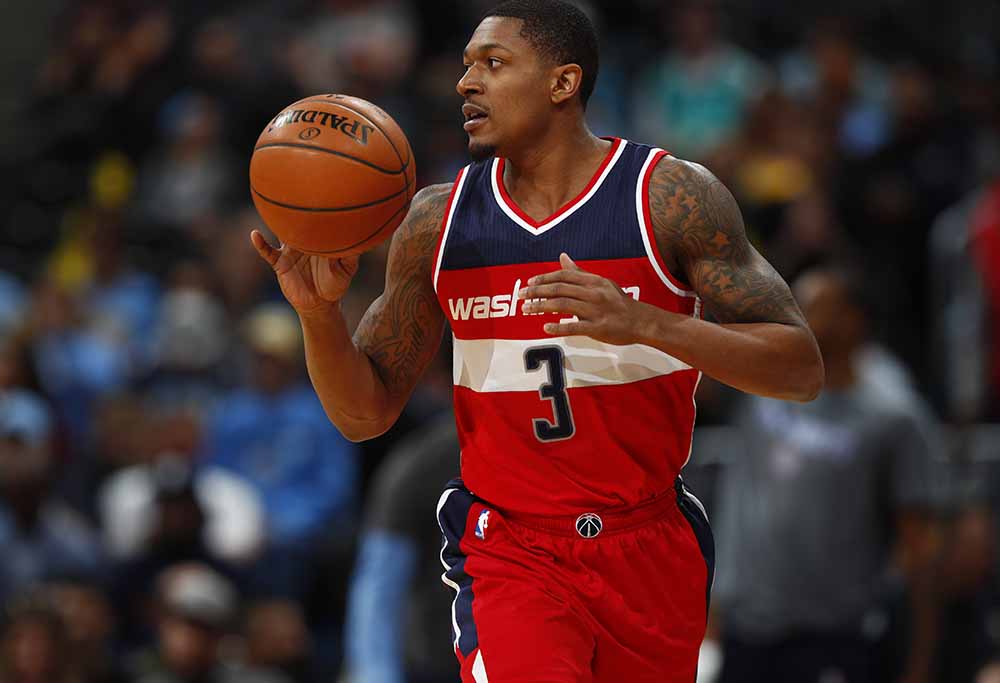LISTEN: Journalist under fire for 'gross... creepy' interaction with Caitlin Clark
https://twitter.com/KatieMox/status/1780695947481174464 https://twitter.com/CWilliamson44/status/1780696642917994703

Bradley Beal’s jump shot is effortlessly smooth – the ball comes out of his hand like his last name comes out of one’s mouth.
He slithers around the court and then hangs in the air, but never gratuitously, a liquid movement, like Kobe Bryant without the God complex.
Unlike Stephen Curry, whose technique defies convention, and Klay Thompson, whose technique is the almost disturbing perfection of convention, Beal’s shot seems, to the layman, replicable.
His release, while swift, is not a shot-put like Curry’s. His mechanics are all classical, from the rising up through the legs to the purposeful flick of the wrist. If Curry’s shot is poetry in motion, then Beal’s is a glorious textbook in motion.
Beal might have the prettiest shot outside of Oakland, and Washington might have the best backcourt outside of Oakland too. John Wall has reclaimed the nuclear athleticism that flirted with deserting him last year after knee issues, and Beal has emerged as a legitimate star.
Since the turn of the new year, Beal has been the best shooting guard in the game (James Harden is, for all intents and purposes, a point guard now).
In 2017, Beal is averaging 24.4 points per game on 51 per cent shooting from the floor, 42 per cent from three on 7.5 attempts, and 84 per cent from the line. That’s good.

The Wizards are crushing teams with Beal on the floor to the tune of positive 8.2 points per 100 possessions. When he sits, they plummet to negative 9.0. That’s the difference between being the Spurs and a slightly drunk version of the Nets.
Beal’s potential has always been tantalising, and now, in its magnificent realisation, it’s exceeded expectations. Until this year Beal was a one-dimensional player, and that dimension was ‘injured’. He’s only missed four games this season, and with his body intact, his production has soared.
His scoring, assists and usage rates are all at career highs, but his efficiency has risen leaps and bounds with them, and his turnovers have remained flat. In 61 games, he’s gone from underwhelming, injury-prone and overpaid to a top 20 to 25 player in the NBA.
Once defined by what he wasn’t doing, Beal is now remarkable because the list of things he can’t do is so small. He’s a capable defender, one of the league’s most devastating three-point bombers, a beyond elite mid-range shooter, and someone who can get to the rim with both an array of subtle moves and bursting athleticism, and finish efficiently when he gets there.
The book on coach Scott Brooks has always been simple – fantastic for culture, deficient in basketball nuance. This season is shattering that perception, in large part because of Beal’s transformation.

Brooks has Beal shooting less long twos than ever before, and taking a much higher percentage of his shots from behind the arc and at the rim. 26 per cent of Beal’s career shots have come from between 16 feet and the three-point line, but this year that number is at 15 per cent. The redistribution of Beal’s shots to the most efficient spots on the floor is a key reason behind the Wizards having a top-10 offence for the first time in the John Wall era.
Behind Beal, the Wizards have developed into Cleveland’s biggest threat in the East. After a woeful 2-8 start to the season that culminated in a loss to the Sixers without Joel Embiid, the Wiz are 39-16, a 58-win season pace.
Their starting line-up of the backcourt stars plus Otto Porto, Markieff Morris and Marcin Gortat is destroying the league at Golden State-type levels, and their bench, for so long a relentless travesty, has suddenly become competent with the additions of Bojan Bogdanovic and Brandon Jennings, and the return of Ian Mahinmi.
Washington, with an eminently navigable closing schedule (outside of a brutal three-game stretch of at Jazz, at Clippers, at Warriors) and Kyle Lowry’s injury, should cruise to the number two or three seed and the right to avoid Cleveland until the Conference Finals. Only two games behind the wounded Cavs right now, they may even catch them for the number one seed.
In Toronto’s best case scenario, Lowry will be rusty and short on time to integrate into a new look team heading into the playoffs, and logic suggests that Boston is not as well-suited to the postseason, where their outstanding depth won’t be as advantageous, and where Isaiah Thomas’s defensive weaknesses will be more severely exploited.
Washington has shown it can win in the playoffs, and when rotations shorten, their vicious starting line-up will only become more imposing. They’ve already played the Cavs tight this year in arguably the game of the season, a game in which, by the way, Bradley Beal dropped 41 points on 57 per cent shooting.
They likely don’t have enough to topple LeBron James, but behind Beal, in a conference that has only offered up broken traffic cones in recent years, the Wizards suddenly loom as the most solid roadblock to the Finals since James returned to Cleveland.